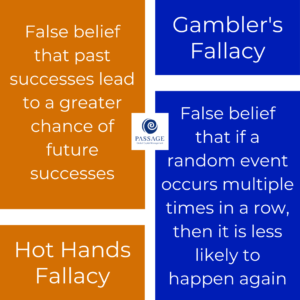
When predicting uncertain, random events, we often take mental shortcuts or go with our gut feelings, which can lead to statistical illusions and suboptimal actions. Our cognitive biases are not consistent with the law of probability because most of us find it frustratingly unintuitive and challenging.
The gambler’s fallacy, also known as the Monte Carlo fallacy (first coined by famous researchers Amos Tversky and Daniel Kahneman in 1971), is a cognitive error that describes our tendency to believe a previous event or series of events can influence the outcome of a future, random event. This can be simply illustrated with a coin toss. If a person flips a fair coin five times and each time it lands on heads, the observer may erroneously conclude the next flip is more likely to be tails. This line of thinking involves an inaccurate understanding of probability. Each coin flip is randomly generated and statistically independent, which means previous flips have no bearing on future flips. If we keep flipping the coin indefinitely, the fraction of heads in the total number of outcomes converges to 50 percent, the long-run average. Ultimately, the gambler’s fallacy is the mistaken belief that random sequences should exhibit systematic reversals.
Another statistical illusion is related to the hot hand in basketball, in which people predict that random sequences will exhibit excessive persistence rather than reversals. Nearly every basketball player, coach, or fan believes that players can have “hot hands,” meaning that they are on a hot streak and are more likely than average to make their next shot. However, in the landmark 1985 paper, The hot hand in basketball: On the misperception of random sequences, psychologists Thomas Gilovich, Robert Vallone, and Amos Tversky (GVT) concluded that the hot hand is a cognitive illusion representing the tendency to detect patterns in randomness. The expectation that a trend will continue in the future is known as the hot hand fallacy.

Disclaimer
The views expressed represent the opinion of Passage Global Capital Management, LLC. The views are subject to change and are not intended as a forecast or guarantee of future results. This material is for informational purposes only. It does not constitute investment advice and is not intended as an endorsement of any specific investment. Stated information is derived from proprietary and nonproprietary sources that have not been independently verified for accuracy or completeness. While Passage Global Capital Management, LLC believes the information to be accurate and reliable, we do not claim or have responsibility for its completeness, accuracy, or reliability. Statements of future expectations, estimates, projections, and other forward-looking statements are based on available information and Passage Global Capital Management, LLC’s views as of the time of these statements. Accordingly, such statements are inherently speculative as they are based on assumptions that may involve known and unknown risks and uncertainties. Actual results, performance, or events may differ materially from those expressed or implied in such statements.